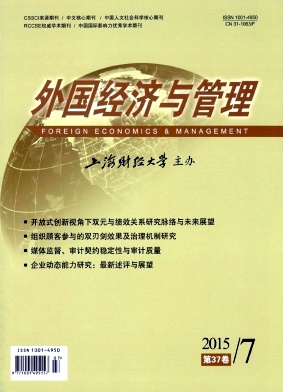普洛格心理类型目的地定位法的引荐与阐释——促成最大化游客量增长的利器
外国经济与管理 2015 年 第 37 卷第 07 期, 页码:
摘要
参考文献
摘要
在旅游市场竞争日益激烈的环境下,目的地定位的重要性愈加突出。然而,当前国内目的地定位普遍遵循一种以识别自身优势属性为核心的运作模式,忽略市场感知和需求规律。本文引荐普洛格的心理类型定位法,即根据目的地生命周期与主流访客心理特征的关联性,将定位着眼于初期目标市场甄选,通过瞄准冒险倾向较强的理想细分市场促成游客量的激增。文章详细阐释了该方法的理论基础和逻辑脉络,并以瑞士案例作为实例解析。
[1]Andergassen R,et alAn economic model for tourism destinations:Product sophistication and price coordination[J]Tourism Management,2013,37:86-79
[2]Butler RThe concept of a tourism area cycle of evolution:Implications for management of resources[J]Canadian Geographer,1980,24(1):5-12
[3]Griffith D A and Albanese P JAn examination of Plog’s psychographic travel model within a student population[J]Journal of Travel Research,1996,34(4):47-51
[4]Hosany S and Prayag GPatterns of tourists’ emotional responses,satisfaction,and intention to recommend[J]Journal of Business Research,2013,66(6):730-737
[5]Jamal S A,et alThe moderating influence of psychographics in homestay tourism in Malaysia[J]Journal of Travel & Tourism Marketing,2011,28(1):48-61
[6]Jani D,et alBig five factors of personality and tourists’ internet search behavior[J]Asia Pacific Journal of Tourism Research,2014,19(5):600-615
[7]Jiang S,et alUsing meansend chain theory to explore travel motivation:An examination of Chinese outbound tourists[J].Journal of Vocation Marketing,2015,21(1):87-100
[8]Li X P,et alThe application of generational theory to tourism consumer behavior:An American perspective[J]Tourism Management,2013,37:147-164
[9]Li X,et alUnderstanding China’s longhaul outbound travel market:An overlapped segmentation approach[J]Journal of Business Research,2013,66(6):786-793
[10]Litvin S WRevisiting Plog’s model of allocentricity and psychocentricityone more time[J]Cornell Hotel and Restaurant Administration Quarterly,2006,47(3):245-253
[11]Liu Z P,et alUsing tourist travel habits and preferences to assess strategic destination positioning:The case of Costa Rica[J]Cornell Hospitality Quarterly,2008,49(3):258-281
[12]Ma M and Hassink RAn evolutionary perspective on tourism area development[J]Annals of Tourism Research,2013,41:89 -109
[13]Masiero L and Zoltan JTourists intradestination visits and transport mode:A bivariate probit model[J]Annals of Tourism Research,2013,43:529-546
[14]Mody M,et alThe different shades of responsibility:Examining domestic and international travelers’ motivations for responsible tourism in India[J]Tourism Management Perspectives,2014,12:113-124
[15]Park JY and Jang S CPsychographics:Static or dynamic?[J]International Journal of Tourism Research,2012,16(4):351-354
[16]Pavelka JPlog in public:Taking tourism theory to practice[J]SCHOLE:A Journal of Leisure Studies and Recreation Education,2013,28(2)
[17]Pike S and Page S JDestination Marketing Organizations and destination marketing:A narrative analysis of the literature[J]Tourism Management,2014,41:202-227
[18]Plog S C“One mo’,once”:A commentary on the Litvin paper on the Plog psychographic system[J]Cornell Hotel and Restaurant Administration Quarterly,2006,47(3):254-259
[19]Plog S CWhy destination areas rise and fall in popularity[J]Cornell Hotel and Restaurant Administration Quarterly,2001,42(3):13-24
[20]Reisinger Y and Turner L WCultural differences between Asian tourist markets and Australian hosts,Part 1[J].Journal of Travel Research,2002,40(3):295-315
[21]Ries A and Trout JPositioning:The Battle for Your Mind[M]New York:McGrawHill,1986
[22]Smith S L JA test of Plog’s allocentric/psychocentric model:Evidence from seven nations[J]Journal of Travel Research,1990,28(4):40-43
[23]Smith S L JAnother look at the carpenter’s tools:A reply to Plog[J]Journal of Travel Research,1990,29(2):50-51
[24]Weaver D BPsychographic insights from a South Carolina protected area[J]Tourism Management,2012,33(2):371-379
[25]Plog S C 著,李天元、李曼译旅游市场营销实论[M].天津:南开大学出版社,2007
[26]陈志永.传统旅游目的地创新发展研究——以云南大理为例[J].贵州教育学院学报(社会科学),2009,25(10):39-42
[27]高静,章勇刚基于目标市场的旅游目的地定位模式研究[J]旅游论坛,2009,2(3):433-438
[28]胡宪洋,马嘉,寇永哲大西安旅游圈旅游规模分布演变及空间特征[J]经济地理,2013,33(6):138-192
[29]李根,段文军.基于IPA的桂林旅游目的地形象游客感知分析[J]中南林业科技大学学报(社会科学版),2014,8(3):1-5
[30]李天元,曲颖旅游目的地定位主题口号设计若干基本问题的探讨——基于品牌要素视角的分析[J]人文地理,2010,25(3):114-116
[31]李天元旅游目的地定位研究中的几个理论问题[J]旅游科学,2007,21(4):1-7
[32]曲颖,李天元旅游目的地非功用性定位研究——以目的地品牌个性为分析指标[J]旅游学刊,2012,27(9):17-25
[33]张宏梅,陆林,朱道才基于旅游动机的入境旅游者市场细分策略——以桂林阳朔入境旅游者为例[J]人文地理,2010,114(4):126-132
[34]张妍妍,李君轶,杨敏基于旅游数字足迹的西安旅游流网络结构研究[J]人文地理,2014,138(4):111-118
[2]Butler RThe concept of a tourism area cycle of evolution:Implications for management of resources[J]Canadian Geographer,1980,24(1):5-12
[3]Griffith D A and Albanese P JAn examination of Plog’s psychographic travel model within a student population[J]Journal of Travel Research,1996,34(4):47-51
[4]Hosany S and Prayag GPatterns of tourists’ emotional responses,satisfaction,and intention to recommend[J]Journal of Business Research,2013,66(6):730-737
[5]Jamal S A,et alThe moderating influence of psychographics in homestay tourism in Malaysia[J]Journal of Travel & Tourism Marketing,2011,28(1):48-61
[6]Jani D,et alBig five factors of personality and tourists’ internet search behavior[J]Asia Pacific Journal of Tourism Research,2014,19(5):600-615
[7]Jiang S,et alUsing meansend chain theory to explore travel motivation:An examination of Chinese outbound tourists[J].Journal of Vocation Marketing,2015,21(1):87-100
[8]Li X P,et alThe application of generational theory to tourism consumer behavior:An American perspective[J]Tourism Management,2013,37:147-164
[9]Li X,et alUnderstanding China’s longhaul outbound travel market:An overlapped segmentation approach[J]Journal of Business Research,2013,66(6):786-793
[10]Litvin S WRevisiting Plog’s model of allocentricity and psychocentricityone more time[J]Cornell Hotel and Restaurant Administration Quarterly,2006,47(3):245-253
[11]Liu Z P,et alUsing tourist travel habits and preferences to assess strategic destination positioning:The case of Costa Rica[J]Cornell Hospitality Quarterly,2008,49(3):258-281
[12]Ma M and Hassink RAn evolutionary perspective on tourism area development[J]Annals of Tourism Research,2013,41:89 -109
[13]Masiero L and Zoltan JTourists intradestination visits and transport mode:A bivariate probit model[J]Annals of Tourism Research,2013,43:529-546
[14]Mody M,et alThe different shades of responsibility:Examining domestic and international travelers’ motivations for responsible tourism in India[J]Tourism Management Perspectives,2014,12:113-124
[15]Park JY and Jang S CPsychographics:Static or dynamic?[J]International Journal of Tourism Research,2012,16(4):351-354
[16]Pavelka JPlog in public:Taking tourism theory to practice[J]SCHOLE:A Journal of Leisure Studies and Recreation Education,2013,28(2)
[17]Pike S and Page S JDestination Marketing Organizations and destination marketing:A narrative analysis of the literature[J]Tourism Management,2014,41:202-227
[18]Plog S C“One mo’,once”:A commentary on the Litvin paper on the Plog psychographic system[J]Cornell Hotel and Restaurant Administration Quarterly,2006,47(3):254-259
[19]Plog S CWhy destination areas rise and fall in popularity[J]Cornell Hotel and Restaurant Administration Quarterly,2001,42(3):13-24
[20]Reisinger Y and Turner L WCultural differences between Asian tourist markets and Australian hosts,Part 1[J].Journal of Travel Research,2002,40(3):295-315
[21]Ries A and Trout JPositioning:The Battle for Your Mind[M]New York:McGrawHill,1986
[22]Smith S L JA test of Plog’s allocentric/psychocentric model:Evidence from seven nations[J]Journal of Travel Research,1990,28(4):40-43
[23]Smith S L JAnother look at the carpenter’s tools:A reply to Plog[J]Journal of Travel Research,1990,29(2):50-51
[24]Weaver D BPsychographic insights from a South Carolina protected area[J]Tourism Management,2012,33(2):371-379
[25]Plog S C 著,李天元、李曼译旅游市场营销实论[M].天津:南开大学出版社,2007
[26]陈志永.传统旅游目的地创新发展研究——以云南大理为例[J].贵州教育学院学报(社会科学),2009,25(10):39-42
[27]高静,章勇刚基于目标市场的旅游目的地定位模式研究[J]旅游论坛,2009,2(3):433-438
[28]胡宪洋,马嘉,寇永哲大西安旅游圈旅游规模分布演变及空间特征[J]经济地理,2013,33(6):138-192
[29]李根,段文军.基于IPA的桂林旅游目的地形象游客感知分析[J]中南林业科技大学学报(社会科学版),2014,8(3):1-5
[30]李天元,曲颖旅游目的地定位主题口号设计若干基本问题的探讨——基于品牌要素视角的分析[J]人文地理,2010,25(3):114-116
[31]李天元旅游目的地定位研究中的几个理论问题[J]旅游科学,2007,21(4):1-7
[32]曲颖,李天元旅游目的地非功用性定位研究——以目的地品牌个性为分析指标[J]旅游学刊,2012,27(9):17-25
[33]张宏梅,陆林,朱道才基于旅游动机的入境旅游者市场细分策略——以桂林阳朔入境旅游者为例[J]人文地理,2010,114(4):126-132
[34]张妍妍,李君轶,杨敏基于旅游数字足迹的西安旅游流网络结构研究[J]人文地理,2014,138(4):111-118
引用本文
曲 颖. 普洛格心理类型目的地定位法的引荐与阐释——促成最大化游客量增长的利器[J]. 外国经济与管理, 2015, 37(7): 0.
导出参考文献,格式为:
上一篇:顾客契合研究综述





 10786
10786  0
0

